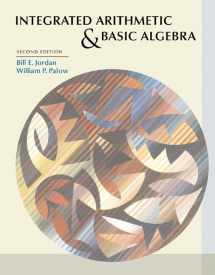
Integrated Arithmetic and Basic Algebra (2nd Edition)
Book details
Summary
Description
A combination of a basic mathematics or prealgebra text with an introductory algebra text, Integrated Arithmetic and Basic Algebra provides a unique, integrated presentation of the material for these courses that is extremely beneficial to students. As opposed to traditional texts that present arithmetic at the beginning and algebra at the end, this text integrates the two whenever possible, so that students see how concepts are interrelated rather than learning them in isolation and missing the "big picture." The ideas and algorithms shared by arithmetic and algebra are introduced in an arithmetic context and then developed through the corresponding algebraic concept. For example, operations with rational numbers and rational expressions are discussed together, whereas most texts discuss operations with rational numbers early on and operations with rational expressions much later. The Jordan/Palow text helps students recognize algebra as a natural extension of arithmetic using variables. This approach aligns directly with NCTM and AMATYC standards, which suggest playing upon students' previous knowledge to teach new concepts.


We would LOVE it if you could help us and other readers by reviewing the book
Book review



